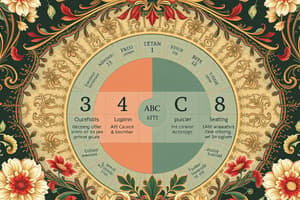Podcast
Questions and Answers
What is the primary goal of customer segmentation?
What is the primary goal of customer segmentation?
- To compare customer demographics with industry averages
- To tailor offerings and services to meet specific customer needs (correct)
- To identify profitable customer segments
- To create customer profiles for marketing purposes
Which of the following is NOT a key component of emotional intelligence?
Which of the following is NOT a key component of emotional intelligence?
- Motivation
- Self-awareness
- Empathy
- Logical reasoning (correct)
What is the primary benefit of personalization in customer interactions?
What is the primary benefit of personalization in customer interactions?
- Improved customer retention rates
- Increased customer loyalty
- Enhanced brand awareness
- Tailored interactions and experiences to individual customers' preferences and needs (correct)
What is the primary purpose of customer journey mapping?
What is the primary purpose of customer journey mapping?
Which of the following is a technique used in client feedback analysis?
Which of the following is a technique used in client feedback analysis?
What is the primary benefit of using firmographic segmentation criteria?
What is the primary benefit of using firmographic segmentation criteria?
Which of the following is a key component of customer journey mapping?
Which of the following is a key component of customer journey mapping?
What is the primary purpose of emotional intelligence in customer-centric businesses?
What is the primary purpose of emotional intelligence in customer-centric businesses?
What is the primary benefit of using psychographic segmentation criteria?
What is the primary benefit of using psychographic segmentation criteria?
What is the primary goal of client feedback analysis?
What is the primary goal of client feedback analysis?
Flashcards are hidden until you start studying
Study Notes
Client Centricity
Customer Segmentation
- Dividing customers into distinct groups based on shared characteristics, needs, and behaviors
- Helps businesses tailor their offerings and services to meet specific customer needs
- Segmentation criteria:
- Demographic (age, gender, occupation)
- Psychographic (values, lifestyle, personality)
- Behavioral (purchase history, usage patterns)
- Firmographic (company size, industry, revenue)
Emotional Intelligence
- Ability to recognize and understand emotions in oneself and others
- Crucial for building strong relationships with customers
- Key components:
- Self-awareness (recognizing one's own emotions)
- Empathy (understanding customer emotions)
- Social skills (effectively communicating with customers)
- Motivation (driving customer-centric decisions)
Personalization
- Tailoring interactions and experiences to individual customers' preferences and needs
- Uses data and analytics to create customized experiences
- Techniques:
- Addressing customers by name
- Offering relevant product recommendations
- Providing targeted content and promotions
Customer Journey Mapping
- Visual representation of the customer's experience across all touchpoints and interactions
- Helps businesses identify pain points, opportunities, and areas for improvement
- Key components:
- Customer thoughts and feelings
- Customer actions and behaviors
- Pain points and challenges
- Opportunities for improvement
Client Feedback Analysis
- Systematic process of collecting, analyzing, and acting on customer feedback
- Helps businesses understand customer needs, preferences, and pain points
- Techniques:
- Surveys and questionnaires
- Net Promoter Score (NPS) analysis
- Social media and online review analysis
- Focus groups and customer interviews
Client Centricity
Customer Segmentation
- Dividing customers into distinct groups based on shared characteristics, needs, and behaviors to tailor business offerings
- Criteria for segmentation: demographic (age, gender, occupation), psychographic (values, lifestyle, personality), behavioral (purchase history, usage patterns), and firmographic (company size, industry, revenue)
Emotional Intelligence
- Recognizing and understanding emotions in oneself and others to build strong customer relationships
- Components of emotional intelligence: self-awareness, empathy, social skills, and motivation
- Importance of emotional intelligence in customer-centric decision making
Personalization
- Tailoring interactions and experiences to individual customers' preferences and needs using data and analytics
- Personalization techniques: addressing customers by name, offering relevant product recommendations, and providing targeted content and promotions
Customer Journey Mapping
- Visual representation of customer experience across all touchpoints and interactions to identify pain points and opportunities
- Components of customer journey mapping: customer thoughts and feelings, customer actions and behaviors, pain points, and opportunities for improvement
Client Feedback Analysis
- Systematic process of collecting, analyzing, and acting on customer feedback to understand customer needs and preferences
- Techniques for client feedback analysis: surveys, Net Promoter Score (NPS) analysis, social media and online review analysis, focus groups, and customer interviews
Studying That Suits You
Use AI to generate personalized quizzes and flashcards to suit your learning preferences.




